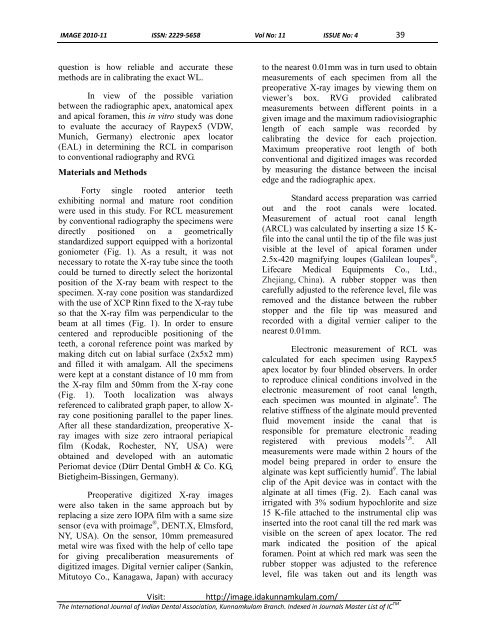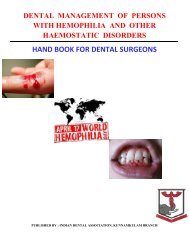'satisfactory smile' with a restorative approach - Indian Dental ...
'satisfactory smile' with a restorative approach - Indian Dental ...
'satisfactory smile' with a restorative approach - Indian Dental ...
You also want an ePaper? Increase the reach of your titles
YUMPU automatically turns print PDFs into web optimized ePapers that Google loves.
IMAGE 2010-11 ISSN: 2229-5658 Vol No: 11 ISSUE No: 4 39<br />
question is how reliable and accurate these<br />
methods are in calibrating the exact WL.<br />
In view of the possible variation<br />
between the radiographic apex, anatomical apex<br />
and apical foramen, this in vitro study was done<br />
to evaluate the accuracy of Raypex5 (VDW,<br />
Munich, Germany) electronic apex locator<br />
(EAL) in determining the RCL in comparison<br />
to conventional radiography and RVG.<br />
Materials and Methods<br />
Forty single rooted anterior teeth<br />
exhibiting normal and mature root condition<br />
were used in this study. For RCL measurement<br />
by conventional radiography the specimens were<br />
directly positioned on a geometrically<br />
standardized support equipped <strong>with</strong> a horizontal<br />
goniometer (Fig. 1). As a result, it was not<br />
necessary to rotate the X-ray tube since the tooth<br />
could be turned to directly select the horizontal<br />
position of the X-ray beam <strong>with</strong> respect to the<br />
specimen. X-ray cone position was standardized<br />
<strong>with</strong> the use of XCP Rinn fixed to the X-ray tube<br />
so that the X-ray film was perpendicular to the<br />
beam at all times (Fig. 1). In order to ensure<br />
centered and reproducible positioning of the<br />
teeth, a coronal reference point was marked by<br />
making ditch cut on labial surface (2x5x2 mm)<br />
and filled it <strong>with</strong> amalgam. All the specimens<br />
were kept at a constant distance of 10 mm from<br />
the X-ray film and 50mm from the X-ray cone<br />
(Fig. 1). Tooth localization was always<br />
referenced to calibrated graph paper, to allow Xray<br />
cone positioning parallel to the paper lines.<br />
After all these standardization, preoperative Xray<br />
images <strong>with</strong> size zero intraoral periapical<br />
film (Kodak, Rochester, NY, USA) were<br />
obtained and developed <strong>with</strong> an automatic<br />
Periomat device (D¸rr <strong>Dental</strong> GmbH & Co. KG,<br />
Bietigheim-Bissingen, Germany).<br />
Preoperative digitized X-ray images<br />
were also taken in the same <strong>approach</strong> but by<br />
replacing a size zero IOPA film <strong>with</strong> a same size<br />
sensor (eva <strong>with</strong> proimage Æ , DENT.X, Elmsford,<br />
NY, USA). On the sensor, 10mm premeasured<br />
metal wire was fixed <strong>with</strong> the help of cello tape<br />
for giving precaliberation measurements of<br />
digitized images. Digital vernier caliper (Sankin,<br />
Mitutoyo Co., Kanagawa, Japan) <strong>with</strong> accuracy<br />
to the nearest 0.01mm was in turn used to obtain<br />
measurements of each specimen from all the<br />
preoperative X-ray images by viewing them on<br />
viewerís box. RVG provided calibrated<br />
measurements between different points in a<br />
given image and the maximum radiovisiographic<br />
length of each sample was recorded by<br />
calibrating the device for each projection.<br />
Maximum preoperative root length of both<br />
conventional and digitized images was recorded<br />
by measuring the distance between the incisal<br />
edge and the radiographic apex.<br />
Standard access preparation was carried<br />
out and the root canals were located.<br />
Measurement of actual root canal length<br />
(ARCL) was calculated by inserting a size 15 Kfile<br />
into the canal until the tip of the file was just<br />
visible at the level of apical foramen under<br />
2.5x-420 magnifying loupes (Galilean loupes Æ ,<br />
Lifecare Medical Equipments Co., Ltd.,<br />
Zhejiang, China). A rubber stopper was then<br />
carefully adjusted to the reference level, file was<br />
removed and the distance between the rubber<br />
stopper and the file tip was measured and<br />
recorded <strong>with</strong> a digital vernier caliper to the<br />
nearest 0.01mm.<br />
Electronic measurement of RCL was<br />
calculated for each specimen using Raypex5<br />
apex locator by four blinded observers. In order<br />
to reproduce clinical conditions involved in the<br />
electronic measurement of root canal length,<br />
each specimen was mounted in alginate 6 . The<br />
relative stiffness of the alginate mould prevented<br />
fluid movement inside the canal that is<br />
responsible for premature electronic reading<br />
registered <strong>with</strong> previous models 7,8 . All<br />
measurements were made <strong>with</strong>in 2 hours of the<br />
model being prepared in order to ensure the<br />
alginate was kept sufficiently humid 9 . The labial<br />
clip of the Apit device was in contact <strong>with</strong> the<br />
alginate at all times (Fig. 2). Each canal was<br />
irrigated <strong>with</strong> 3% sodium hypochlorite and size<br />
15 K-file attached to the instrumental clip was<br />
inserted into the root canal till the red mark was<br />
visible on the screen of apex locator. The red<br />
mark indicated the position of the apical<br />
foramen. Point at which red mark was seen the<br />
rubber stopper was adjusted to the reference<br />
level, file was taken out and its length was<br />
Visit: http://image.idakunnamkulam.com/<br />
The International Journal of <strong>Indian</strong> <strong>Dental</strong> Association, Kunnamkulam Branch. Indexed in Journals Master List of IC TM



